Menu
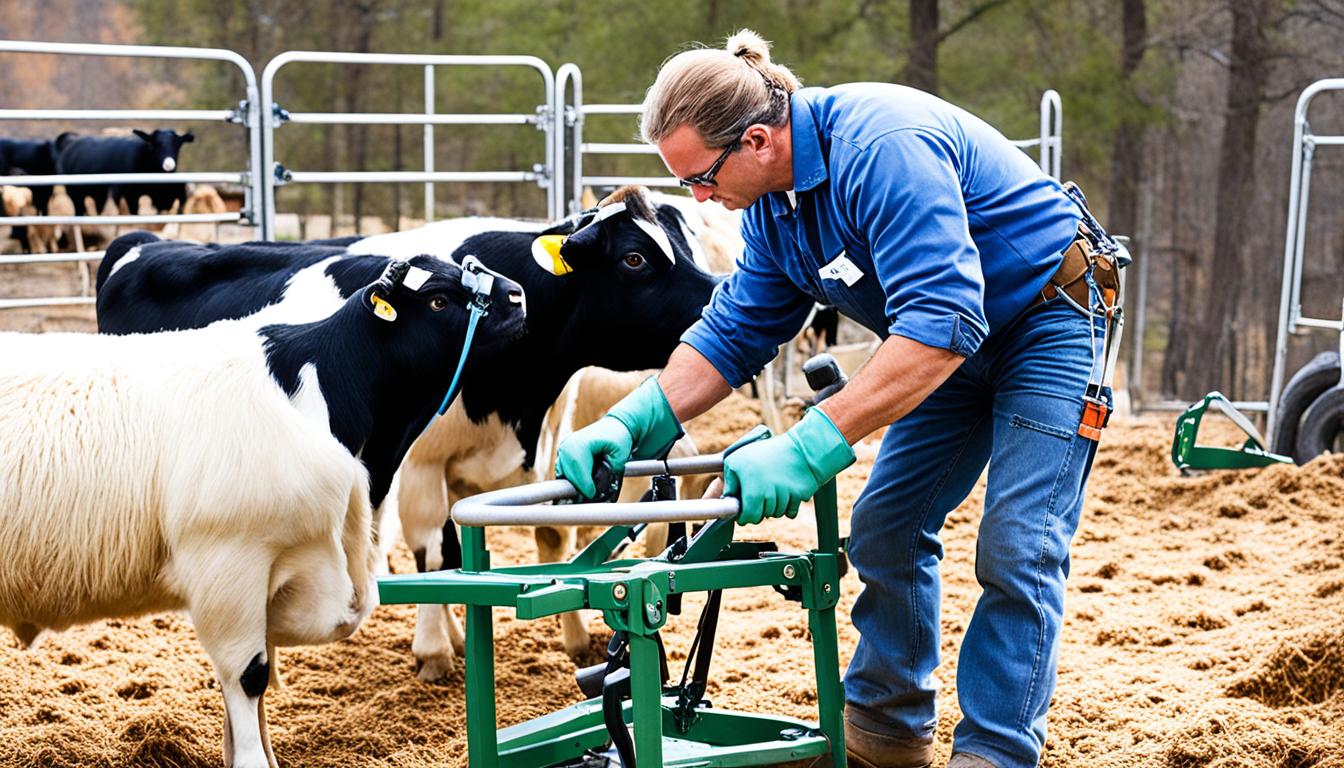
Did you know that in the United States, musculoskeletal disorders (MSDs) cost over $12 billion a year? They also affect almost one million people annually. We often associate ergonomics with offices, thinking of adjustable chairs and computer screens. But, it’s just as important in livestock handling. Ergonomics here aims to make the workspaces in agriculture fit the needs of the workers. This helps their health, makes them more productive, and looks after the animals better.
Ergonomics in agriculture helps manage livestock better and reduces the risk of injury for workers and animals. It tackles issues like sprains and strains, using ergonomic tools to make farms safer and more efficient.
The core of livestock management ergonomics focuses on good designs for farm work. These designs aim to take care of humans and animals well. They also reduce stress and the chance of getting hurt. For the last forty years, studies have shown it’s key to think of animals as smart creatures. This pushes for approaches that put people and animal well-being first.
Ergonomics includes areas like applied ethology. They help improve the way people and animals work together. Yet, research in these areas is not as much as we need. Most studies try to make handling of animals better by understanding how they connect with humans.
Almost every job on a farm has its own challenges that are hard on your body. For example, in one year in Queensland, over 1000 injury claims were about body aches from farm work. In New South Wales, in a different year, the most common injuries were in the chest, belly, and back. They made up a big part of all claimed injuries. These injuries are not just painful but also costly to treat. In Queensland alone, treating these injuries cost over $3,500,000.
Common Manual Handling Problems in Livestock Handling:
Using ergonomics can help fix many of these problems on the farm. By adding livestock management ergonomics and livestock welfare ergonomics into daily work, we make looking after animals more efficient. We also make sure that workers stay healthy. This section mentions why using ergonomics well is important and calls for more smart solutions for the livestock business.
In the world of livestock, being aware of your space is essential. Good livestock handling ergonomics practices require an in-depth knowledge of how animals act. They also need a strategy to keep the working area safe for everyone. Setting up clear rules helps achieve this.
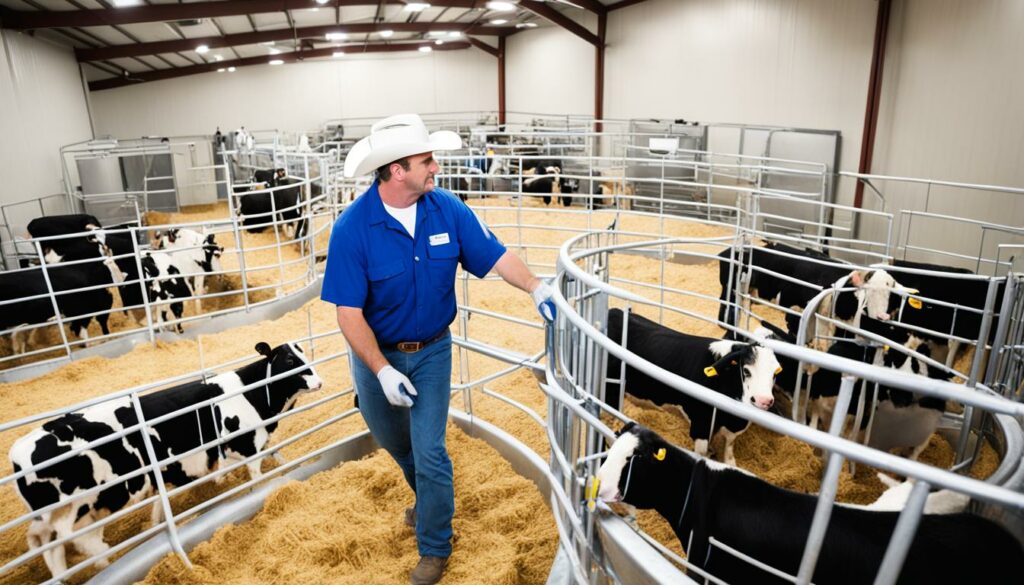
Getting rid of obstacles is key in ergonomic solutions for livestock handling. It means making sure paths are clear so workers can move quickly and without danger. The best way to keep things safe is by taking away these hazards.
Doing regular checks with a Job Hazard Analysis (JHA) removes obstacles fast. It’s a smart, preventive step that falls in line with OSHA’s advice. This makes working with livestock much safer.
Keeping a distance from animals is also very important. It stops injuries to workers and beasts. By following livestock handling ergonomics practices and standing back, handlers can stay safe if animals startle.
Training is crucial. It ensures workers know how to keep safe. They learn to watch the animals and maintain a safe zone. This lessens stress for the animals and makes it easier to handle them.
Knowing how livestock move helps avoid accidents. It lets handlers plan better and build paths that animals find easy to follow. These paths make handling them smoother and less risky.
Looking at the past three years of OSHA data helps spot common risks. This info is key in prioritising safety. And, keeping an eye out for new dangers and adjusting paths is ongoing work to keep handling practices safe and effective.
To sum up, being aware of your surroundings is vital in livestock handling ergonomics practices. It includes having clear paths, standing back from animals, and knowing how they move. This all adds up to a safer and better way to work with livestock.
Making sure there are safe escape routes when handling livestock is very important. Having a clear plan to leave can help avoid injuries to people. First, we need to think about what dangers might be there. This helps everyone stay safe.
It’s key to check the area for risks before you enter where the animals are. Look for things like badly designed yards, slippery floors, and animals that might be aggressive. Knowing about these dangers helps handlers get ready to escape if they need to.
Using the right stance can make dealing with animals safer. Standing in a way that does not scare the animals, like standing sideways, is good. It makes the animals less likely to get upset.
Also, staying balanced and ready to move quickly is important. This helps handlers stay safe and in control if an animal acts in a strange way.
It’s crucial to use ergonomic solutions when working with livestock. Handling animals the right way is very important for the safety of both people and the animals. Thinking about risks and using safe ways to move around can make the place safer for everyone.
It’s key to act right around animals for everyone’s sake. A relaxed approach without loud noises is vital. This helps create a calm place for animals, making handling them easier and safer for all.
Being calm and relaxed is powerful. It affects how animals behave and feel. By moving slowly and speaking gently, handlers show they mean no harm. This leads to better cooperation with fewer chances of being hurt.
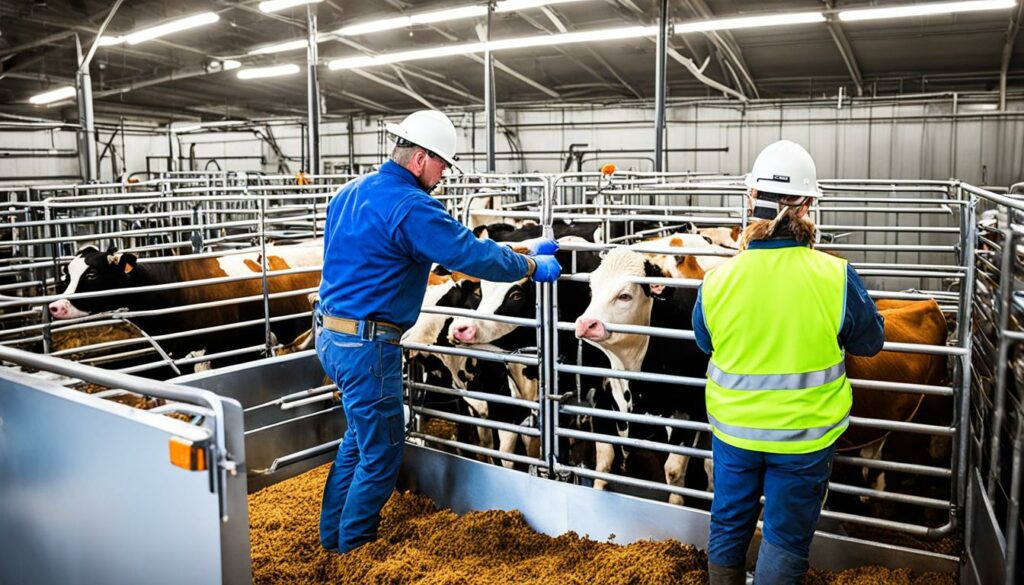
Loud sounds can scare livestock, making them do unexpected things. This could cause harm. So, keeping quiet around animals is best. It keeps them calm for easier and safer handling.
Every animal has a ‘flight zone’, their own space. If this is invaded, they move away. Knowing and respecting this helps manage livestock without upsetting them. It makes things safer and less stressful for everyone.
Following these rules cuts down on work accidents and boosts farm life. It’s part of always trying to do better – the Shewart Plan-Do-Check-Act way. This keeps things improving for the handlers and the animals they care for.
Mother and calf interactions in farming need careful management. Mothers are very protective. Good ergonomics in livestock handling helps reduce stress. This ensures safety for both animals and people.
The Codes of Practice by the NFACC set standards for looking after farm animals. They cover how animals should be housed, fed, and handled. These rules aim to improve animal welfare.
The Dairy Code of Practice, for example, focuses on providing enough space and good air quality for dairy cows. It also highlights the need for gentle handling. This is vital for the safety and health of calves and their mothers.
Scientific data shows that handling animals well leads to better relationships. This involves keeping the environment quiet. Handlers should move smoothly and stand at a safe distance. This stops the animals from becoming defensive.
When dealing with calves, it’s key to handle them gently. This is during things like weighing. Studies find that how long people spend weighing a calf often varies. This shows a need for set practices to make handling more consistent and safe.
Building a good relationship with animals can make them more productive. Dairy cows, for instance, produce less milk when they’re scared of people. So, using good ergonomics in livestock handling is good for the animals and for the farm’s output.
To sum up, managing mother and calf care well with proper ergonomic methods is essential. It keeps the animals safe and boosts farm performance. This approach brings a positive balance between caring for the animals and the farm’s success.
“Research indicates that positive human-animal relationships can significantly impact animal welfare.”
Working with cattle needs clever solutions to keep both people and animals safe. These solutions help reduce risks and make the farm a better place for workers.
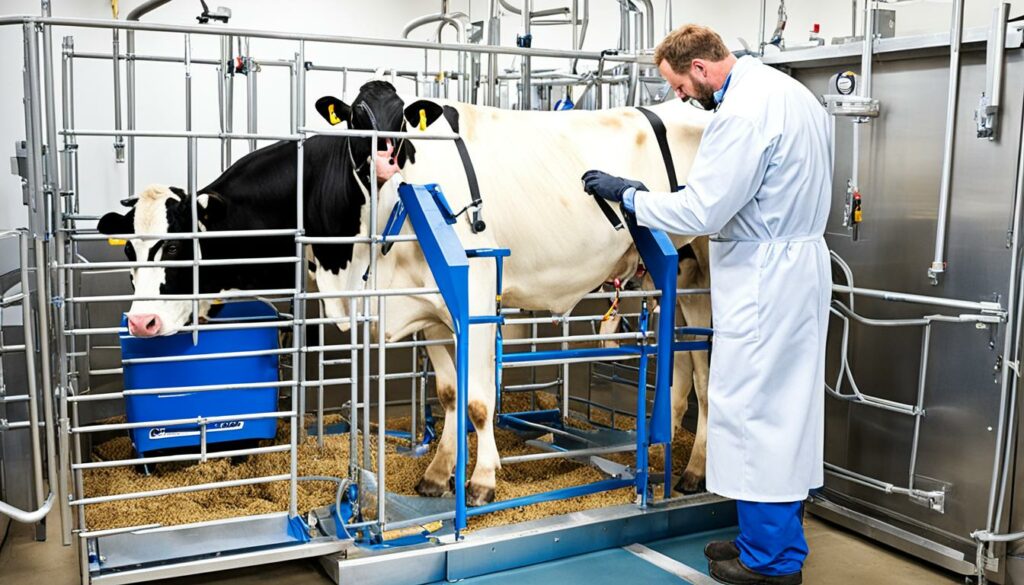
Getting close to cattle means knowing about their space and behaviour. Farm work often comes with tough ergonomic challenges. A careful, quiet approach is best, as it lessens the chance of accidents. This approach also cuts down on health issues like back pain.
Keeping paths clear and staying at a safe distance helps avoid harm. These steps help stop common farm injuries that hurt the body.
Speaking to cattle in the right way helps keep them calm. Using a gentle, even voice guides them smoothly. This method aligns with ergonomic care, meaning better, safer work for farmers. It also lessens the risk of muscle injuries, which are common in the farming world.
Knowing how cows move and live together is key for good ergonomics. Carefully planned movements prevent injuries. These are often avoidable but can be serious.
It’s not just about tools; how we do the work matters too. Cattle should move at an easy speed, using tools to help. This makes work safer and more efficient. Expert advice and new technologies can show us the best ways to handle cattle.
Using ergonomic principles in livestock care improves worker safety and animal care. It means using tools and equipment specially designed for workers. This includes things like animal restraints and feeding systems. It makes handling animals easier and less tiring for people.
In the United States, sprains and strains are common on farms. They cause a lot of pain and expense. Many people suffer these injuries every year. They cost over 12 billion dollars. Ergonomic tools can help prevent these injuries.
Studies show that using ergonomic designs for handling equipment can reduce injuries by 30%. They also make farms more efficient. Nearly nine out of ten farmers say ergonomic equipment has made a big difference. It means they work better and don’t need to use as much force with the animals.
Making farm surfaces non-slip and using proper equipment reduce animal injuries by a quarter. Training farmers in using this equipment has also made a big change. Farmers have become 20% better at handling animals safely and effectively.
Using RFID tags for livestock has reduced inventory mistakes by 15%. Farms that use advanced technology have seen a 35% boost in productivity. This is because of automation and better data collection.
When farms use ergonomic designs, workers get less tired and injured. Farmers say animal stress has also decreased by 40%. This leads to healthier and happier animals.
Teaching farm workers about ergonomic equipment reduces accidents by 25%. This type of training follows a plan to continuously improve. It helps make sure workers stay safe and farms run well.
The following table outlines the impact of implementing ergonomic principles and tools in livestock handling:
| Aspect | Traditional Handling | Ergonomic Handling |
|---|---|---|
| Operational Efficiency | Moderate | 89% Improved |
| Farm Injuries | High | 30% Reduced |
| Worker Fatigue | High | 50% Reduced |
| Animal Stress Levels | High | 40% Reduced |
| Productivity | Moderate | 35% Increased |
Ergonomics play a big role in milking. It’s crucial for both the animals’ health and the workers’. Without proper techniques, there’s a big risk of health issues. These can be avoided through ergonomics. This makes work safer and more comfortable.
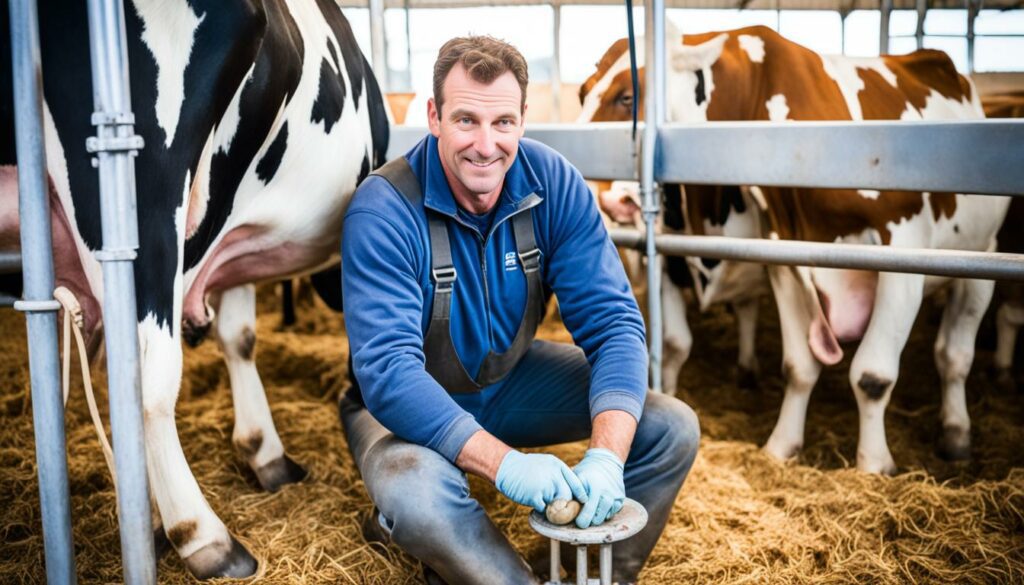
Securing the cow well is the start of good milking ergonomics. This means using ties or headlocks. It stops the cow from moving suddenly. A cow that’s calm is safer for the handler. It helps reduce the chance of getting hurt.
Leg ropes and hip clamps are great for milking the right way. They keep the cow steady. This makes the handler’s job easier. Plus, it’s good for the handlers’ backs and muscles. They face a lot of strain, but these tools help a lot.
Taking breaks is key to avoid muscle injuries. In past years, a lot of worker’s injuries were due to this. Regular rests help ease muscle tension. This reduces the chance of getting sick from work, like tendonitis or back pain.
By focusing on ergonomics, milking becomes safer and more efficient. It helps workers stay healthy. Less injuries mean less hard work. This makes the whole farming process better.
| Ergonomic Technique | Benefits |
|---|---|
| Securing the Cow | Minimises abrupt movements and reduces strain-related injuries |
| Using Leg Ropes and Hip Clamps | Enhances stability and reduces need for awkward postures |
| Taking Breaks | Alleviates muscular stress and prevents repetitive strain injuries |
Using these techniques helps every day on the farm. It makes work better for both the people and the animals.
It’s vital to tackle ergonomic risks in looking after livestock. Sprains and strains rank as the second most common work injury in the United States. This makes it crucial to think about how to reduce these risks. MSDs cost over 12 billion dollars a year in the US due to workplace injuries. They impact nearly a million workers annually, causing high medical bills.
Livestock handling involves postures that can lead to MSDs. For example, over 60% of tasks in a vet’s work require awkward postures. This can hurt productivity and the health of those working with the animals. More than 70% of jobs need strong hand use, which can tire out muscles and cause injuries.
Almost half of the tasks in handling livestock involve repeating the same movements. This can really tire out muscles and lead to overuse injuries like tendonitis. Tasks like lifting heavy objects make up about 60% of what workers do. This makes their chance of getting hurt even higher.
Following a careful plan for ergonomics can cut down on MSDs. Good ergonomic solutions in handling livestock can lower both the direct and hidden costs of injuries at work. By putting in place proven programmes, we can help workers stay healthy. This means less sprains, strains, and other injuries.
Using ergonomics tools can really help in tasks that are often repeated, like giving injections. Specially designed workspaces and tools lessen the risk from motorised tools or hand tools with a lot of vibration. These kinds of tools are in use in around 30% of vet jobs.
To sum up, it’s crucial to deal with ergonomic risks in looking after livestock. Getting the right ergonomic solutions boosts worker safety and the way livestock handling is done.
Using ergonomic solutions in livestock care makes work safer for staff and ensures animals are treated well. Almost all farm tasks, from using machines to handling livestock, are difficult on the body. These tasks can lead to injuries like back problems and broken bones. For example, in New South Wales, 25% of injuries worth compensating were sprains and strains. In Queensland, over 1,000 claims in one year were because of such injuries, costing over $3,500,000.
Farm workers often get hurt, showing why it’s important to care for livestock with good ergonomic practices. Using these methods can lower the chances of getting hurt. There are laws and standards to help guide this, like the National Code of Practice for Manual Handling [NOHSC:1001(1990)].
To make livestock handling better, we must follow ergonomic rules and use the right equipment. This not only protects workers but also makes sure animals are dealt with well. For instance, when stunning cattle and sheep, a single shot should make them unable to feel pain at least 95% of the time. For pigs, the use of electric wands should be right 99% of the time, and only 4% of gas stunning chambers should have too many pigs inside.
Doing well in ergonomic livestock care needs ongoing checks. For examples, when stunning pigs, noise should be kept low, ideally under 50% of the time. Also, we should avoid using prods too much yet handle animals gently. There shouldn’t be harm like using prods on their sensitive areas. This is about keeping high ethical standards.
To show the importance of ergonomics in livestock care, let’s look at some handling standards:
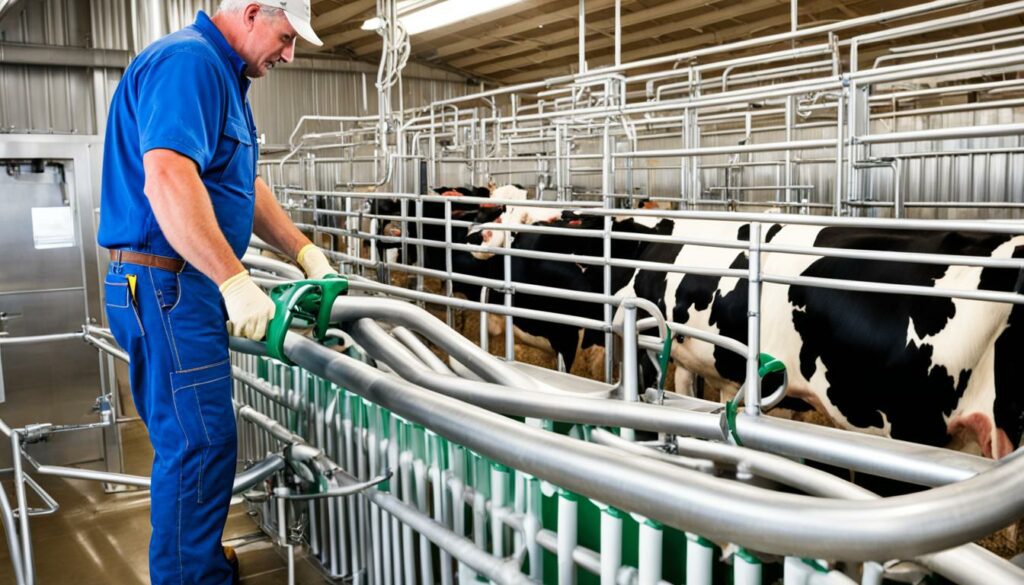
| Species | Handling Standard | Acceptable Percentage |
|---|---|---|
| Cattle | Rendered Insensible with One Shot | 95% |
| Pigs | Correct Wand Position | 99% |
| Gas-Stunned Pigs | Gondolas Overload Limit | 4% |
| All Species | Maximum Allowable Falls | 1% |
| All Species | Slipping Allowance | 3% |
| Cattle | Max Allowable Vocalisation | 3% |
| Pigs | Max Allowable Vocalisation | 5% |
| Pigs | Stunning Cycle Noise | 50% |
| Cattle and Pigs | Prod Usage | 25% |
| Sheep | Prod Usage | 5% |
By using these ergonomic methods, we can make life better for both farm workers and animals. It’s vital we keep improving our ways based on solid ergonomic rules. This will lead to a nicer and safer workplace in the livestock industry.
An ergonomics program aims to make life easier for people working with animals. It focuses on cutting down pain and making tasks easier. By using ergonomic ideas, the risk of getting conditions like MSDs goes down.
This is important as in the US, MSDs cost over $12 billion every year. They affect almost a million people. So, a good ergonomics plan is vital to fight these problems.
Ergonomics in the workplace can lessen injuries and save business a lot of money. It can also keep workers healthy. With clear goals and good processes, companies can reduce sprains and strains, especially in tough jobs like meatpacking.
A well-planned ergonomics program can do wonders for workers. It reduces the bad effects of demanding jobs like tiredness and mistakes. This leads to a better life for workers and a safer work setting.
For instance, Goodvalley made safer shoes and saw 30% fewer accidents. This shows how ergonomics can directly improve safety.
Making mistakes in taking care of livestock can affect both workers and animals. Using the right tools, training, and equipment lessens these mistakes. OSHA shows that bad ergonomics can increase workplace problems. A strong ergonomics approach is key to cutting these issues.
| Ergonomics Program Objectives | Benefits |
|---|---|
| Reducing Pain and Suffering | Less workplace injuries, improved worker well-being |
| Improving Human Performance | Increased productivity, decreased fatigue |
| Minimising Errors | Fewer injuries, better animal welfare |
By focusing on these goals, organisations can make a good ergonomics plan. This plan will make work safer for people and better for animals.
Administrative controls in looking after livestock mostly need making policies, training, and job swapping. These steps help lessen risks. By putting these controls into practice on farms and in barns, workers face fewer dangers. This makes their work safer.
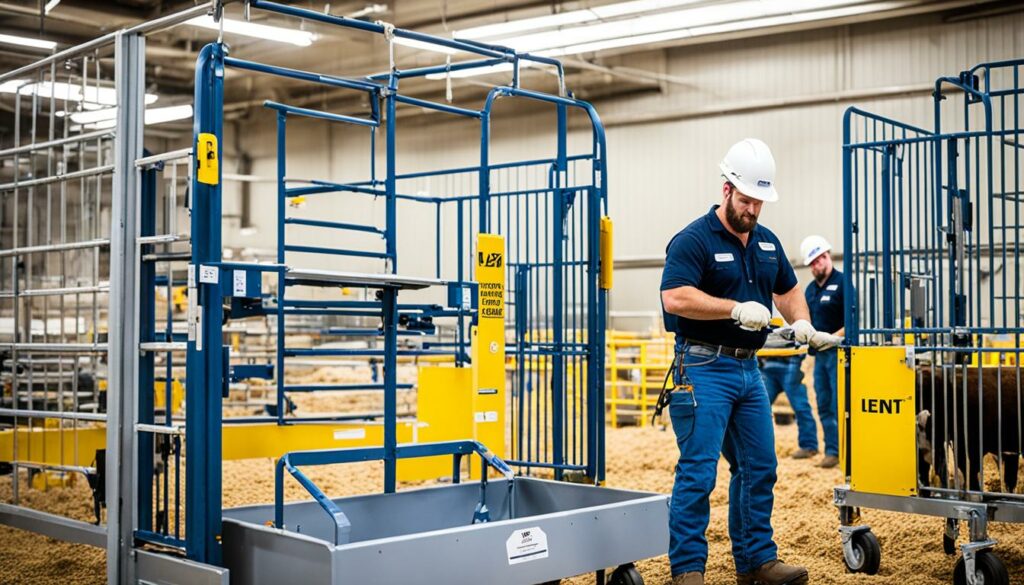
Spains and strains rank second in causing injuries at work in the USA. These hurt not only the employees but also affect work. Their medical bills are usually three to five times greater. Yet, by using the right rules, these can be cut down. This is vital for the health and success of the workforce.
“Ergonomic initiatives are most effective when applied in a systematic fashion consistent with existing best practices.”
Ergonomics should be tightly linked with health and safety plans. This includes the Shewart Plan-Do-Check-Act pattern to keep growing. To make this work, leaders should offer help and the right setup.
In looking after animals, spotting and dealing with dangers is key. The aim is to get rid of dangers, then use the right machines, and set rules. Everyone must also wear the right protective gear.
| Aspect | Impact |
|---|---|
| Sprains and Strains | Second most prevalent occupational injury in the US |
| Musculoskeletal Disorders (MSDs) | Over $12 billion per year in direct costs, affecting nearly one million people annually |
| Workplace Injuries | Three to five times the direct medical costs when considering all work-related factors |
It’s wise to have a team working on safety with many skills. They should look closely at risky jobs using records of accidents and near-misses.
Training is key, and must often cover known risks. It has to be checked to make sure it works. Everyone should know what’s going on to keep the workplace safe.
By setting up these plans, we take care of the work environment. This is good for the people working there and for the animals.
Engineering controls are key for better livestock handling ergonomics. They adjust the work environment to make tasks easier and less stressful for workers. With the latest ergonomic tools and equipment, we boost efficiency and safety in the livestock sector.
Creating ergonomic workstations is vital. They match workers’ movements and posture, cutting down on awkward positions. These happen in more than half of vet tasks.
Good workstation design also lessens the need for forceful actions and repetitive movements. It also reduces exposure to vibrations, which are common work hazards. This makes daily work smoother and safer.
Using adjustable tables in livestock management helps a lot. They keep workers in a good position, reducing effort. This is important for almost a quarter of veterinary jobs.
These tables can be set to each worker’s height. They boost comfort and job performance. This reduces the chance of muscle and skeletal issues.
Hoists are great for lifting heavy items, cutting down on work strain. In vet clinics, where vibrations are common, hoists are valuable for moving animals and tools safely. They also reduce the risk of repeated impact injuries, making livestock handling operations more secure and efficient.
To learn more about veterinary ergonomic guidelines, click here.
| Ergonomic Concern | Percentage |
|---|---|
| Awkward Postures | 54% |
| High Hand Force | 23% |
| Highly Repetitive Motion | 2:1 |
| Forceful Exertions | 31% |
| Moderate to High Vibration | 12% |
In the livestock handling world, it is key to do ergonomic evaluations to keep workers safe. With agriculture as the second highest for injuries, this step is critical. These evaluations look into the job site, focusing on things like lifting a lot or bending awkwardly, which often cause muscle and bone problems.
Vineyards highlight the danger from lifting a lot and bending in odd ways. Weeding, on the other hand, needs long bending and holding, which result in various body pains. Changing how tasks are done, like using special tools, can lower these risks.
Regular evaluations help find problems and bring solutions to help the staff. Simply changing the type of tables people work on, or using hoists for lifting heavy items can make a big difference. Doing these checks often makes the work area safer and better for everyone.
Ergonomics in livestock handling is about making the workplace better for farmers. It aims to improve their health, work performance, and care for the animals.
It’s important to clear paths and keep a safe distance from animals. Knowing where the animals move helps to avoid injuries. This makes accidents less likely and keeps the animals safe.
Thinking ahead about dangers and using body language to show you’re not a threat helps. Having clear escape paths is key to staying safe when working with animals.
Approaching animals calmly and quietly is best. It’s important to know how close you can get without scaring them. These methods ensure working with the animals goes well for everyone.
Extra care is needed when mothers are involved. It’s vital to keep the handler safe and not stress the animals. This makes sure both the animals and the workers are safe.
Approach cattle quietly and know how they move in groups. This makes working with them safer and more effective.
Special tools and gear can make it safer to work with animals. These include things like restraints and tools for feeding.
Securing cows safely and taking breaks prevents injuries. This makes milking better for both the cow and the person doing it.
One big risk is hurting your muscles and bones. Knowing how to avoid these injuries is very important for everyone’s health.
By matching jobs to human abilities, we can make working with livestock safer. This leads to a better and safer working place.
The aim is to reduce pain, do more work, and make fewer mistakes. A good ergonomics plan helps take better care of the animals and the workers.
Making rules, teaching people, and changing jobs helps lower the risk of injury. This supports a work environment where everyone can be safer.
Changing the way the workplace is set up can help people stay healthy. Things like special chairs and tables make work easier on the body.
Checking on how safe the workplace is needs to happen regularly. Doing this right helps keep making things better to work in.